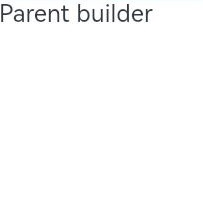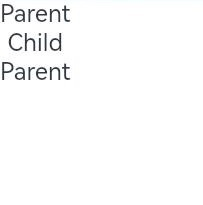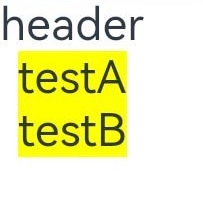harmony 鸿蒙\@BuilderParam Decorator: @Builder Function Reference
\@BuilderParam Decorator: @Builder Function Reference
In certain circumstances, you may need to add a specific function, such as a click-to-jump action, to a custom component. However, embedding an event method directly inside of the component will add the function to all places where the component is imported. This is where the \@BuilderParam decorator comes into the picture. \@BuilderParam is used to decorate a custom component member variable of type reference to an \@Builder method. When initializing a custom component, you can assign a value to the variable, thereby adding the specific function to the custom component. This decorator can be used to declare an element of any UI description, similar to a slot placeholder.
NOTE
Since API version 9, this decorator is supported in ArkTS widgets.
Rules of Use
Initializing \@BuilderParam Decorated Method
An \@BuildParam decorated method can be initialized only by an \@Builder function reference.
- Local initialization with the owning component’s custom \@Builder function or a global \@Builder function reference
@Builder function GlobalBuilder0() {}
@Component
struct Child {
@Builder doNothingBuilder() {};
@BuilderParam aBuilder0: () => void = this.doNothingBuilder;
@BuilderParam aBuilder1: () => void = GlobalBuilder0;
build(){}
}
- Initialization from the parent component
@Component
struct Child {
@Builder FunABuilder0() {}
@BuilderParam aBuilder0: () => void = this.FunABuilder0;
build() {
Column() {
this.aBuilder0()
}
}
}
@Entry
@Component
struct Parent {
@Builder componentBuilder() {
Text(`Parent builder `)
}
build() {
Column() {
Child({ aBuilder0: this.componentBuilder })
}
}
}

- this in the function body points to the correct object.
In the following example, when the Parent component calls this.componentBuilder(), this.label points to the owning component, that is, Parent. With \@BuilderParam aBuilder0 passed to the Child component from \@Builder componentBuilder(), when the Child component calls this.aBuilder0(), this.label points to the label of the child component, that is, Child. For \@BuilderParam aBuilder1, when this.componentBuilder is passed to aBuilder1, bind is called to bind this. Therefore, this.label points to the label of the parent component.
NOTE
Exercise caution when using bind to change the context of function invoking, which may cause this to point to an incorrect object.
@Component
struct Child {
label: string = `Child`
@Builder FunABuilder0() {}
@Builder FunABuilder1() {}
@BuilderParam aBuilder0: () => void = this.FunABuilder0;
@BuilderParam aBuilder1: () => void = this.FunABuilder1;
build() {
Column() {
this.aBuilder0()
this.aBuilder1()
}
}
}
@Entry
@Component
struct Parent {
label: string = `Parent`
@Builder componentBuilder() {
Text(`${this.label}`)
}
build() {
Column() {
this.componentBuilder()
Child({ aBuilder0: this.componentBuilder, aBuilder1: ():void=>{this.componentBuilder()} })
}
}
}

Application Scenarios
Component Initialization Through Parameters
An \@BuilderParam decorated method can be a method with or without parameters. Whether it contains parameters should match that of the assigned \@Builder method. The type of the \@BuilderParam decorated method must also match that of the assigned \@Builder method.
class Tmp{
label:string = ''
}
@Builder function GlobalBuilder1($$ : Tmp) {
Text($$.label)
.width(400)
.height(50)
.backgroundColor(Color.Blue)
}
@Component
struct Child {
label: string = 'Child'
@Builder FunABuilder0() {}
// Without parameters. The pointed componentBuilder is also without parameters.
@BuilderParam aBuilder0: () => void = this.FunABuilder0;
// With parameters. The pointed GlobalBuilder1 is also with parameters.
@BuilderParam aBuilder1: ($$ : Tmp) => void = GlobalBuilder1;
build() {
Column() {
this.aBuilder0()
this.aBuilder1({label: 'global Builder label' } )
}
}
}
@Entry
@Component
struct Parent {
label: string = 'Parent'
@Builder componentBuilder() {
Text(`${this.label}`)
}
build() {
Column() {
this.componentBuilder()
Child({ aBuilder0: this.componentBuilder, aBuilder1: GlobalBuilder1 })
}
}
}

Component Initialization Through Trailing Closure
In a custom component, the \@BuilderParam decorated attribute can be initialized using a trailing closure. During initialization, the component name is followed by a pair of braces ({}) to form a trailing closure.
NOTE
In this scenario, the custom component has one and only one \@BuilderParam decorated attribute.
You can pass the content in the trailing closure to \@BuilderParam as an \@Builder decorated method. Example:
// xxx.ets
@Component
struct CustomContainer {
@Prop header: string = '';
@Builder CloserFun(){}
@BuilderParam closer: () => void = this.CloserFun
build() {
Column() {
Text(this.header)
.fontSize(30)
this.closer()
}
}
}
@Builder function specificParam(label1: string, label2: string) {
Column() {
Text(label1)
.fontSize(30)
Text(label2)
.fontSize(30)
}
}
@Entry
@Component
struct CustomContainerUser {
@State text: string = 'header';
build() {
Column() {
// Create the CustomContainer component. During initialization, append a pair of braces ({}) to the component name to form a trailing closure.
// Used as the parameter passed to CustomContainer @BuilderParam closer: () => void.
CustomContainer({ header: this.text }) {
Column() {
specificParam('testA', 'testB')
}.backgroundColor(Color.Yellow)
.onClick(() => {
this.text = 'changeHeader';
})
}
}
}
}

你可能感兴趣的鸿蒙文章
harmony 鸿蒙app.json5 Configuration File
harmony 鸿蒙Internal Structure of the app Tag
harmony 鸿蒙Application Configuration File Overview (FA Model)
harmony 鸿蒙Application Configuration File Overview (Stage Model)
harmony 鸿蒙Application Installation and Uninstallation Process
harmony 鸿蒙Application Package Overview
harmony 鸿蒙Application Package Structure in FA Model
- 所属分类: 后端技术
- 本文标签: